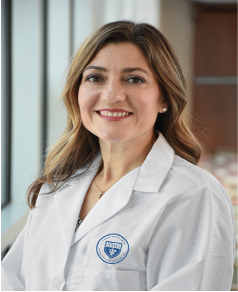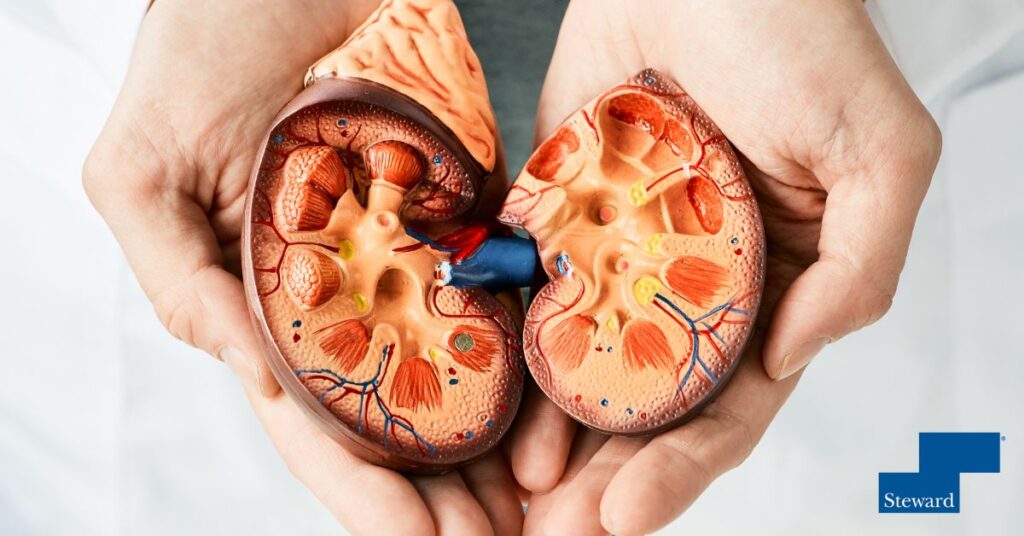July is Hemochromatosis Awareness Month. To learn more about the causes, symptoms, and treatment options for this common genetic disorder, Steward sat down with Meredythe McNally, MD, a gastroenterologist at Trumbull Regional Medical Center, and Bonnie Carter, MD, a family medicine specialist at Odessa Regional Medical Center.
 Dr. Meredythe McNally earned her medical degree from Northeastern Ohio Universities College of Medicine (NEOUCOM), now known as NEOMED, in Rootstown, OH. Dr. McNally completed her Internal Medicine Residency as well as her Gastroenterology and Hepatology Fellowship at the Mayo Clinic College of Medicine in Rochester, MN. She is board certified in gastroenterology, and her clinical interests include Inflammatory Bowel Disease, Celiac disease, and Gastroesophageal Reflux Disease (GERD).
Dr. Meredythe McNally earned her medical degree from Northeastern Ohio Universities College of Medicine (NEOUCOM), now known as NEOMED, in Rootstown, OH. Dr. McNally completed her Internal Medicine Residency as well as her Gastroenterology and Hepatology Fellowship at the Mayo Clinic College of Medicine in Rochester, MN. She is board certified in gastroenterology, and her clinical interests include Inflammatory Bowel Disease, Celiac disease, and Gastroesophageal Reflux Disease (GERD).

Dr. Bonnie Carter earned her medical degree from Texas Tech University Health Sciences Center School of Medicine in Lubbock, TX. Dr. Carter completed her residency at Texas Tech in Amarillo, TX. She is board certified in Family Medicine and a Fellow of the American Academy of Family Physicians. Her clinical interests include general family practice, pediatrics, and sports medicine.
What is hemochromatosis?
The most common form of Hemochromatosis is a genetically inherited disorder typically found in those of northern European descent. One in 300 non-Hispanic Caucasians carries the hemochromatosis genes, and one is only at risk of developing hemochromatosis if they inherit the gene from both of their parents. The inheritance of this gene affects your ability to absorb iron, which causes the intestines to absorb too much iron. Your body stores the excess iron in your joints, heart, and liver and damages them.
What is Secondary Hemochromatosis?
Secondary hemochromatosis is when you receive an overload of iron from other sources, as opposed to primary hemochromatosis, which is a genetic disorder. Secondary hemochromatosis occurs when the body receives excessive iron from an outside source. It’s usually patients who require multiple blood transfusions who develop secondary hemochromatosis. Patients with conditions such as hemophilia, sickle cell disease, leukemia, and myelodysplastic disorders., severe liver disease, alcoholic cirrhosis, and hepatitis B or C are at risk of developing secondary hemochromatosis.
What are the common symptoms of hemochromatosis?
Common symptoms include severe fatigue, joint aches and pains, abdominal pain, a bronze, grayish look to the skin, and the development of diabetes. Additionally, lab abnormalities can be a sign that one has the disorder. Since these symptoms are so unspecific, many people are not diagnosed until it is too late.
Is there preventive screening someone can take?
While primary hemochromatosis involves genetic testing, secondary hemochromatosis requires a series of lab tests. The Ferritin test is the best screening test; however, it is not a common screening lab in your annual exam. The first test your physician may prescribe is the Ferritin test, which measures how much iron you have stored in your body. If the result of this test is high, then you’ll be asked for Serum Iron, Iron Binding Capacity, % Iron Saturation, and Transferrin tests. These are the tests your physician will look at for secondary hemochromatosis.
How does hemochromatosis affect day-to-day life?
Hemochromatosis can cause chronic pain, such as arthritis. It can also cause cirrhosis, which in turn can cause liver cancer. Patients can also develop heart issues as a result of the condition.
How can you treat hemochromatosis? What are the best next steps after a diagnosis?
Treatments include Iron Chelation therapy (when iron chelators enter cells, bind free iron, and remove it from the body), oral treatments, and bloodletting. Bloodletting involves periodically taking blood from patients—since most iron in a patient’s body is in their blood—and measuring their subsequent iron levels.
Are there foods and activities that someone with Hemochromatosis should avoid?
Patients with hemochromatosis will want to eat a healthy diet and limit or avoid iron-fortified foods and supplements. Hemochromatosis patients do not necessarily have to avoid red meats but may pair red meats with foods that reduce iron absorption (such as grains, nuts, teas, and green leafy vegetables). Alcohol consumption should be limited or discontinued. Alcohol increases iron absorption: the heavier the alcohol mixed with the iron, the more likely you are to develop liver damage like cirrhosis. Vitamin C also increases the absorption of iron. While it is ok to have some vitamin C in your diet, you should try to avoid vitamin C supplements and pairing foods with high doses of vitamin C with iron-rich foods.
To find a doctor or schedule an appointment, visit Steward DoctorFinder™.




